Mind over matter: the great fuel debate
Page 20
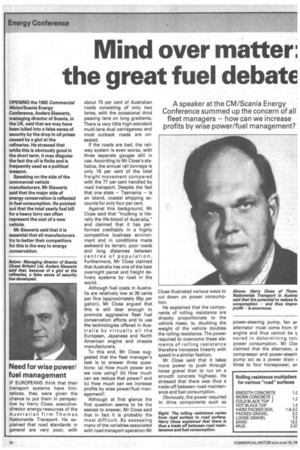
Page 21
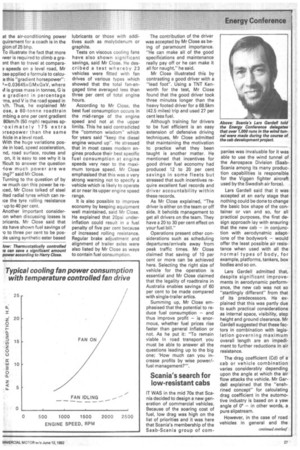
Page 22
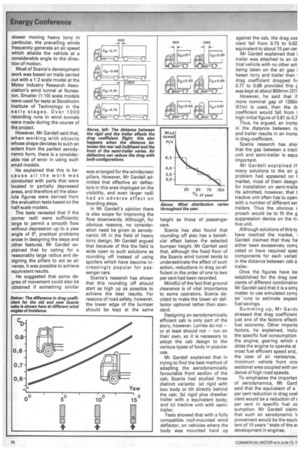
Page 23
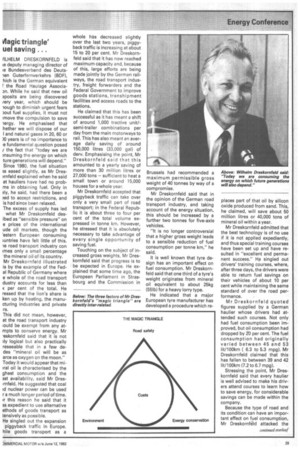
Page 24
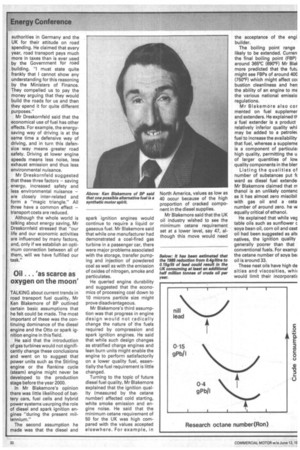
Page 25
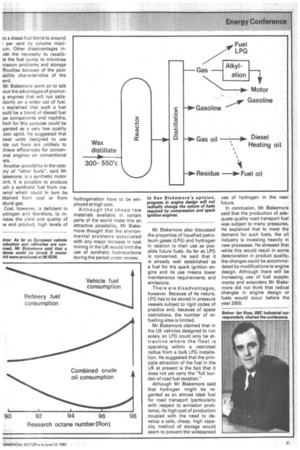
If you've noticed an error in this article please click here to report it so we can fix it.
A speaker at the CM/Scania Energy Conference summed up the concern of all fleet managers — how can we increase profits by wise power/fuel management?
OPENING the 1982 Commercial MotoriScania Energy Conference, Anders Siewertz, managing director of Scan ia, in the UK, said that we may have been lulled into a false sense of security by the drop in oil prices caused by a glut at the refineries. He stressed that while this is obviously good in the short term, it may disguise the fact the oil is finite and is frequently used as a political weapon.
Speaking on the side of the commercial vehicle manufacturers, Mr Siewertz said that the major side of energy conservation is reflected in fuel consumption. He pointed out that the total yearly fuel bill for a heavy lorry can often represent the cost of a new vehicle.
Mr Siewertz said that it is essential that all manufacturers try to better their competitors for this is the way to energy conservation.
Need for wise power/ fuel management
IF EUROPEANS think that their transport systems have limitations, they were given the chance to put them in perspective by Harry Close, executivedirector energy-resources of the Australian firm Thomas Nationwide Transport. He explained that road standards in general are very poor, with about 75 per cent of Australian roads consisting of only two lanes, with the occasional third passing lane on long gradients. There is very little high-standard multi-lane dual carriageway and most outback roads are unsealed.
If the roads are bad, the railway system is even worse, with three separate gauges still in use. According to Mr Close's statistics, the annual rail tonnage is only 18 per cent of the total freight movement compared with the 77 per cent handled by road transport. Despite the fact that one state — Tasmania — is an island, coastal shipping accounts for only four per cent.
Against this background, Mr Close said that "trucking is literally the life-blood of Australia," and claimed that it has performed creditably in a highly competitive business environment and in conditions made awkward by terrain, poor roads and long distances between centres of population. Furthermore, Mr Close claimed that Australia has one of the best overnight parcel and freight delivery systems by road in the world.
Although fuel costs in Australia are relatively low at 36 cents per litre (approximately 95p per gallon), Mr Close argued that this is still dear enough to promote aggressive fleet fuel conservation efforts and to use the technologies offered in Australia by virtually all the European, Japanese and North American engine and chassis manufacturers.
To this end, Mr Close suggested that the fleet manager's task is to answer three questions: (a) How much power are we now using? (b) How much can we reduce that power? and (c) How much can we increase profits by wise power/fuel management?.
Although at first glance the first question seems to be the easiest to answer, Mr Close said that in fact it is probably the most difficult. By assessing many of the variables associated with road transport operation Mr Close illustrated various ways to cut down on power consumption.
He explained that the components of rolling resistance are directly proportionate to the vehicle mass; ie, doubling the weight of the vehicle doubles the rolling resistance. The power required to overcome these elements of rolling resistance therefore increases linearly with speed in a similar fashion.
Mr Close said that it takes more power to push through loose gravel than to run on a smooth concrete highway. He stressed that there was thus a trade-off between road maintenance and fuel consumption.
Obviously, the power required to drive components such as power-steering pump, fan ar alternator must come from th engine and thus cannot be 4 nored in determining tote power consumption. Mr CloE claimed that the alternator, a compressor and power-steerir pump act as a power drain three to four horsepower, an at the air-conditioning power quirement for a coach is in the gion of 25 bhp.
To illustrate the fact that more rwer is required to climb a graant than to travel at compare3 speeds on a level road, Mr Dse applied a formula to calcue this "gradient horsepower": )=0.03645xGMxGxV, where v1 is gross mass in tonnes, G is e gradient in percentage .ms, and V is the road speed in 1/h. Thus, he explained Mr ose, a 60-tonne roadtrain mbing a one per cent gradient 80km/h (50 mph) requires ap.oxim ate I y 175 extra usepower than the same hide in a level road.
With the huge variations pos)le in load, speed acceleration, nd, road surface, routes and on, it is easy to see why it is fficult to answer the question -low much power are we ing?" said Mr Close.
Turning to the question of by ■ w much can this power be reiced, Mr Close talked of steel Ited radial tyres which can reice the tyre rolling resistance • up to 40 per cent.
Another important consideron when discussing losses is aricants. Mr Close said that gs have shown fuel savings of ,o to three per cent to be pos)le using synthetic ester based
lubricants or those with additives such as molybdenum or graphite.
Tests on viscous cooling fans have also shown significant savings, said Mr Close. He described a test whereby 23 vehicles were fitted with fan drives of various types which showed that the total fan-engaged time averaged less than three per cent of total engine hours.
According to Mr Close, the best fuel consumption occurs in the mid-range of the engine speed and not at the upper limits. This he said contradicted the "common wisdom" which for years said "keep the diesel engine wound up". He stressed that in most cases modern engines produce their best specific fuel consumption at engine speeds very near to the maximum torque speed. Mr Close emphasised that this was a very strong warning not to specify a vehicle which is likely to operate at or near its upper engine speed range.
It is also possible to improve economy by keeping equipment well maintained, said Mr Close. He explained that 20psi underinflation could result in a fuel penalty of five per cent because of increased rolling resistance. Regular brake adjustment and alignment of trailer axles were also listed by Mr Close as ways to contain fuel consumption. The contribution of the driver was accepted by Mr Close as being of paramount importance. "He can make all of the good specifications and maintenance really pay off or he can make it all for naught," he said.
Mr Close illustrated this by contrasting a good driver with a "lead foot". Using a TNT Kenworth for the test, Mr Close found that the good driver took three minutes longer than the heavy footed driver for a 68.5km (42.5 miles) trip and used 27 per cent less fuel.
Although training for drivers to be fuel efficient is an easy extension of defensive driving techniques, Mr Close admitted that maintaining the motivation to practice what they been taught is another matter. He mentioned that incentives for good driver fuel economy had produced 12 to 20 per cent savings in some fleets but stressed that such incentives require excellent fuel records and driver accountability within these records.
As Mr Close explained, "The driver is either on the team or off side. It beholds management to get all drivers on the team. They have a 20 to 30 per cent effect on your fuel bill."
Operations present other considerations such as scheduling departures/arrivals away from peak traffic times. Mr Close claimed that saving of 10 per cent or more can be achieved here. Selecting the right size of vehicle for the operation is essential and Mr Close claimed that the legality of roadtrains in Australia enables savings of 60 per cent to be made compared with single-trailer artics.
Summing up, Mr Close emphasised that the potential to reduce fuel consumption — and thus improve profit — is enormous, whether fuel prices rise faster than general inflation or not. As he put it: "To remain viable in road transport you must be able to answer all the questions leading up to the big one; 'How much can you increase profits by wise power/fuel management?".
Scan ia's search for low-resistant cabs
IT WAS in the mid 70s that Scania decided to design a new generation of commercial vehicles. Because of the soaring cost of fuel, low drag was high on the list of priorities and it was here that Scania's membership of the Saab-Scania group of corn panies was invaluable for it was able to use the wind tunnel of the Aerospace Division (SaabScania among its many production capabilities is responsible for the Viggen fighter aircraft used by the Swedish air force).
Lars Garda said that it was accepted at an early stage that nothing could be done to change the basic box shape of the container or van and so, for all practical purposes, the first design approath lay with ensuring that the new cab — in conjunction with aeroclynarnic adaptions of the bodywork — would offer the least possible air resistance when used with all the normal types of body, for example; platforms, tankers, box bodies and so on.
Lars Gardell admitted that, despite significant improvements in aerodynamic performance, the new cab was not so "startlingly different" from that of its ' predecessors. He explained that this was partly due to such practical considerations as internal space, visibility, step height and ground clearance. Mr Gardell suggested that these factors in combination with legislation governing maximum overall length are an impediment to further reductions in air resistance.
The drag coefficient (Cd) of a cab or vehicle combination varies considerably depending upon the angle at which the air flow attacks the vehicle. Mr Gardeli explained that the "enshrined concept" for calculating drag coefficient in the automotive industry is based on a yaw angle of 00 — in other words, a pure slipstream.
However, in the case of road vehicles in general and the slower moving heavy lorry in particular, the prevailing winds frequently generate an air speed which attacks the vehicle at a considerable angle to the direction of motion.
Mostof Scania's development work was based on trails carried out with a 1:2 scale model at the Motor Industry Research Association's wind tunnel at Nuneaton. Smaller (1:10) scale models were used for tests at Stockholm Institute of Technology in the early stages. Over 1000 recording runs in wind tunnels were made during the course of the project.
However, Mr Gardell said that, when working with objects whose shape deviates to such an extent from the perfect aerodynamic form, there is a considerable risk of error in using such small models.
He explained that this is because all the work was conducted with parts that were located in partially depressed areas, and therefore all the absolute figures were derived from the evaluation tests based on the half-scale models.
The tests revealed that if the corner radii were sufficiently large to permit a smooth flow without depression up to a yaw angle of 5°, practical problems arose in designing the steps and other features. Mr Gardell explained that by opting for a reasonably large radius and designing the pillars to act as air vanes, it was possible to achieve equivalent results.
He suggested that some degree of movement could also be obtained if something similar was arranged for the windscreen pillars. However, Mr Gardell admitted that effective air deflectors in this area impinged on the visibility, and even larger radii had an adverse effect on boarding steps.
In Mr Gardell's opinion there is also scope for improving the flow downwards. Although, for obvious reasons, no consideration need be given to aerodynamic lift in the field of heavy lorry design, Mr Gardell argued that because of this the field is wide open to such solutions as rounding off instead of using spoilers which have become increasingly popular for passenger cars.
Scania's research has shown that this rounding off should start as high up as possible to achieve the best results. For reasons of road safety, however, the lower edge of the bumper should be kept at the same height as those of passenger cars.
Scania has also found that rounding off also has a beneficial effect below the selected bumper height. Mr Gardell said that, although the fixed floor of the Scania wind tunnel tends to underestimate the effect of such action, reductions in drag co-efficient in the order of one to two per cent had been recorded.
Mindful of the fact that ground clearance is of vital importance to some operators, Scania decided to make the lower air deflector optional rather than standard.
Designing an aerodynamically efficient cab is only part of the story, however. Lorries do not — or at least should not — run on their own, so it is necessary to adopt the cab design to the various types of body in popular use.
Mr Gardell explained that in trying to find the best method of adapting the aerodynamically favourable front section of the cab, Scania had studied three distinct variants: (a) rigid with box body or tilt directly behind the cab; (b) rigid plus drawbar trailer with a equivalent body; and (c) tractive unit with semitrailer.
Tests showed that with a fully compatible roof-mounted wind deflector, on vehicles where the body was mounted hard up against the cab, the drag coe cient fell from 0.73 to 0.62 equivalent to about 15 per cer
Mr Gardell explained that i trailer was attached to an id tical vehicle with no other act: being taken on the air gap I tween lorry and trailer then 1 drag coefficient dropped fn 0.77 to 0.68 provided this r. was kept at about 800mm (31i
However, he said that if more nominal gap of 1300n (51in) is used, then the di coefficient would fall from 1 high initial figure of 0.81 to 0.7
.Thus, he argued, an increE in the distance between ric and trailer results in an increE in drag coefficient.
Scania research has shoi that the gap between a tracti unit and semi-trailer is equa important.
Mr Gardell explained th many solutions to the air g problem had appeared on t market, most of them design for installation on semi-traile He admitted, however, that t tractive unit often has to open with a number of different ser trailers. Thus the obvious E proach would be to fit the g suppression device on the tn tive unit.
Although solutions of this ty have reached the market, I Gardell claimed that they ha either been excessively comr cated or have required spec components for each variati in the distance between cab a trailer.
Once the figures have be established for the drag coe. cients of different combinatior Mr Gardell said that it is a sirrq matter to use simulated comr ter ' runs to estimate expect fuel savings.
Summing up, Mr Garth stressed that drag coefficient just one of the factors affectii fuel economy. Other imports factors, he explained, inclu the specific fuel consumption the engine, gearing which E ables the engine to operate at most fuel efficient speed and, the case of air resistance, minimum vehicle front crcq sectional area coupled with avi dance of high road speeds.
To emphasise the importan of aerodynamics, Mr Gard said that the equivalent of a per cent reduction in drag cod cient would be a reduction of E per cent in specific fuel co sumption. Mr Gardell claim! that such an aerodynamic ii provement would be the equix. lent of 10 years "state of the at development in engines.
11agic triangle' uel saving .
fILHELM DRESKORNFELD is le deputy managing director of ie Bundesverband des Deutslen Guterfernverkehrs (BDF), hich is the German equivalent F the Road Haulage AssociaDM While he said that new oil aposits are being discovered nary year, which should be 'tough to diminish urgent fears out fuel supplies, it must not move the compulsion to save lergy. He emphasised that hether we will dispose of our I and natural gases in 20, 60 or )0 years is of no importance to le fundamental question posed I the fact that "today we are msuming the energy on which ture generations will depend." Since 1980, the fuel situation 3s eased slightly, as Mr Oresirnfeld explained when he said at hauliers have had no probms in obtaining fuel. Only in ily, he said, had there been a )ed to accept restrictions, and is had since been relaxed.
The excess of supply has led
what Mr Dreskornfeld desibed as "sensible pressure" on e prices of the international ude oil markets, though the 'estern European consuming iuntries have felt little of this. le road transport industry con Imes only a small percentage the mineral oil of its country. Mr Dreskornfeld illustrated is by the example of the Fedal Republic of Germany where e whole of the road transport dustry accounts for less than K per cent of the total. He ressed that the lion's share is ken up by heating, the manucturing industries and private This did not mean, however, at the road transport industry iould be exempt from any atmots to conserve energy. Mr -eskornfeld said that it is not ily logical but also practically reseeable that in a few dedes "mineral oil will be as arce as oxygen on the moon." Today it would appear that mi:rail oil is characterised by the ghest consumption and the 3st availability, said Mr Dres,rnfeld. He suggested that coal id nuclear power can be used r a much longer period of time. ir this reason he said that it 3S expedient to use alternative ethods of goods transport as tensively as possible.
He singled out the expansion piggyback traffic in Europe. hile goods transport as a whole has decreased slightly over the last two years, piggyback traffic is increasing at about 15 to 20 per cent. Mr Dreskornfeld said that it has now reached maximum capacity and, because of this, large efforts are being made jointly by the German railways, the road transport industry, freight forwarders and the Federal Government to improve goods stations, transhipment facilities and access roads to the stations.
He claimed that this has been successful as it has meant a shift of around 1,000 tractive unit/semi-trailer combinations per day from the main motorways to rail. This has also meant an average daily saving of around 150,000 litres (33,000 gal) of dent. Emphasising the point, Mr Dreskornfeld said that this amounted to a yearly saving of more than 30 million litres or 27,000 tons — sufficient to heat a small town or around 15,000 houses for a whole year.
Mr Dreskornfeld accepted that piggyback traffic can take over only a very small part of road transport; in the Federal Republic it is about three to four per cent of the total volume expressed in tonne km. However, he stressed that it is absolutely necessary to take advantage of every single opportunity of saving fuel.
Touching on the subject of increased gross weights, Mr Dreskornfeld said that progress is to be expected in Europe. He explained that some time ago, the European Parliament in Strasbourg and the Commission in Brussels had recommended a maximum permissible gross weight of 40 tonnes by way of a compromise.
Mr Dreskornfeld said that in the opinion of the German road transport industry, and taking account of the energy situation, this should be increased by a further two tonnes for five-axle vehicles.
"It is no longer controversial that a higher gross weight leads to a sensible reduction of fuel consumption per tonne km," he said.
It is well known that tyre design has an important effect on fuel consumption. Mr Dreskornfeld said that one third of a tyre's weight originates from mineral oil equivalent to about 25kg (55IW for a heavy lorry type.
He indicated that a major European tyre manufacturer has developed a procedure which re places part of that oil by silicon oxide produced from sand. This, he claimed, will save about 50 million litres or 40,000 tons of mineral oil within a year.
Mr Dreskarnfeld admitted that the best technology is of no use if it is not applied expediently, and thus special training courses have been set up and have resulted in "excellent and permanent success." Hp singled out drivers' training courses, where, after three days, the drivers were able to return fuel savings on their vehicles of about 10 per cent while maintaining the same standard of over the road performance.
Mr Dreskornfeld quoted figures supplied by a German haulier whose drivers had attended such courses. Not only had fuel consumption been improved, but oil consumption had dropped by /0 per cent. The fuel consumption had originally varied between 45 and 53 lit/100km ( 6.3 to 5.3 mpg). Mr Dreskornfeld claimed that this has fallen to between 39 and 42 lit/100km (7.2 to 6.7 mpg).
Stressing the point, Mr Dreskornfeld said that every haulier is well advised to make his drivers attend courses to learn how to save energy, for considerable savings can be made within the company.
Because the type of road and its condition can have an important effect on fuel consumption, Mr Dreskornfeld attacked the authorities in Germany and the UK for their attitude on road spending. He claimed that every year, road transport pays much more in taxes than is ever used by the Government for road building. "I must state quite frankly that I cannot show any understanding for this reasoning by the Ministers of Finance. They compelled us to pay the money arguing that they would build the roads for us and then they spend it for quite different purposes."
Mr Dreskornfeld said that the economical use of fuel has other effects. For example, the energysaving way of driving is at the same time a defensive way of driving, and in turn this defensice way means greater road safety. Driving at lower engine, speeds means less noise, less exhaust emission and thus less environmental nuisance.
Mr Dreskornfeld suggested that these three factors — saving energy, increased safety and less environmental nuisance — are closely inter-related and form a "magic triangle." All three have a common effect — transport costs are reduced.
Although the whole world is talking about energy saving, Mr Dreskornfeld stressed that "our life and our economic activities are influenced by many factors, and, only if we establish an optimum connection between all of them, will we have fulfilled our task."
Oil . . 'as scarce as oxygen on the moon'
TALKING about current trends in road transport fuel quality, Mr Ken Blakemore of BP outlined certain basic assumptions that he felt could be made. The most important of these was the continuing dominance of the diesel engine and the Otto or spark ignition engine in this field.
He said that the introduction of gas turbines would not significantly change these conclusions and went on to suggest that power units such as the Stirling engine or the Rankine cycle (steam) engine might never be developed to the production stage before the year 2000.
In Mr Blakemore's opinion there was little likelihood of battery cars, fuel cells and hybrid power systems usurping the role of diesel and spark ignition engines "during the present millennium."
The second assumption he made was that the diesel and spark ignition engines would continue to require a liquid or gaseous fuel. Mr Blakemore said that while one manufacturer had demonstrated a coal-fired gas turbine in a passenger car, there were major problems associated with the storage, transfer pumping and injection of powdered coal as well as with the emission of oxides of nitrogen, smoke and particulates.
.He queried engine durability and suggested that the economics of processing coal down to 10 microns particle size might prove disadvantageous.
Mr Blakemore's third assumption was that progress in engine design would not radically change the nature of the fuels required by compression and spark ignition engines. He said that while such design changes as stratified charge engines and lean burn units might enable the engine to perform satisfactorily on a lower quality fuel, essentially the fuel requirement is little changed.
Turning to the topic of future diesel fuel quality, Mr Blakemore explained that the ignition quality (measured by the cetane number) affected cold starting, white smoke emission and engine noise. He said that the minimum cetane requirement of 50 for the UK was high compared with the values accepted elsewhere. For example, in North America, values as low as 40 occur because of the high proportion of cracked component in the diesel supplies.
Mr Blakemore said that the UK oil industry wished to see the minimum cetane requirement set at a lower level, say 47, although this move would need the acceptance of the engi builder.
The boiling point range likely to be extended. Curren the final boiling point (FBP) around 3650C (690°F) Mr Blab more predicted that the futu might see FBPs of around 400 (750°F) which might affect col bustion cleanliness and hen the ability of an engine to ME the various national emissio regulations.
Mr Blakemore also cor mented on fuel supplemer and extenders. He explained if a fuel extender is a product relatively inferior quality whi may be added to a petrolei. fuel to increase the availability that fuel, whereas a suppleme is a component of particulai high quality, permitting the u of larger quantities of low quality components in the blen Listing the qualities of number of substances put fc ward as diesel fuel extende Mr Blakemore claimed that rn thanol is an unlikely contenc as it has almost zero miscibil with gas oil and a ceta number of around zero. he w equally critical of ethanol.
He explained that while veg table oils such as sunflower c soya bean oil, corn oil and cast oil had been suggested as aft( natives, the ignition quality generally poorer than that conventional fuels. For exampl the cetane number of soya be oil is around 33.
These neat oils have high de sities and viscosities, whic would limit their incorporati( to a diesel fuel blend to around per cent by volume maxiurn. Other disadvantages inJcle the necessity to recalibte the fuel pump to minimise nission problems and storage fficulties because of the poor ability characteristics of the end.
Mr Blakemore went on to talk )out the advantages of promotg engines that will run satisctorily on a wider cut of fuel. .3 explained that such a fuel ould be a blend of diesed fuel pe components and naphtha, hich for this purpose could be garded as a very low quality otor spirit. He suggested that 3wer units designed to use ide cut fuels are unlikely to ;hieve efficiencies for convenNiel engines on conventional Another possibility in the cateDry of "other fuels", said Mr lakemore, is a synthetic motor airit. It is possible to produce J ch a synthetic fuel from melanol which could in turn be btained from coal or from atural gas.
Coal, however, is deficient in ydrogen and therefore, to inrease the yield and quality of le end product, high levels of hydrogenation have to be employed at high cost.
Although the cheap raw materials available in certain parts of the world make this an attractive possibility, Mr Blakemore thought that the environmental problems associated with any major increase in coal mining in the UK would limit the use of synthetic hydrocarbons during the period under review.
Mr Blakemore also .discussed the properties of liquefied petroleum gases (LPG) and hydrogen in relation to their use as possible future fuels. As far as LPG is concerned, he said that it is already well established as a fuel for the spark ignition engine and its use means lower maintenance requirements and emissions.
There are disadvantages, however. Because of its nature, LPG has to be stored in pressure vessels subject to rigid codes of practice and, because of space restrictions, the number of refuelling sites is limited.
Mr Blakemore claimed that in the UK vehicles designed to run solely on LPG could only be attractive where the fleet is operating within a restricted radius from a bulk LPG installation. He suggested that the principle attraction of the fuel in the UK at present is the fact that it does not yet carry the "full burden of road fuel taxation."
Although Mr Blakemore said that hydrogen might be regarded as an almost ideal fuel for road transport (particularly with respect to emission problems), its high cost of production Coupled with the need to develop a safe, cheap, high capacity method of storage would seem to prevent the widespread use of hydrogen in the near future.
In conclusion, Mr Blakemore said that the production of adequate quality road transport fuel was subject to many pressures. He explained that to meet the demand for such fuels, the oil industry is investing heavily in new processes. He stressed that while this would result in some deterioration in product quality, the changes could be accommodated by modifications to engine design. Although there will be increasing use of fuel supplements and extenders Mr Blakemore did not think that radical changes in engine design or fuels would occur before the year 2000.






















































